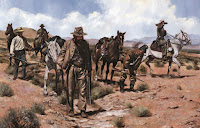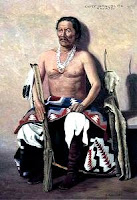Born in Northern Ireland, James “Paddy” Graydon became a noted figure in the American West who confronted rampaging Indians, Confederate soldiers and gun-toting outlaws during a single violent decade (1853-1863) punctuated by his running an Arizona drinking establishment and hotel the locals called Casa Blanca. The Graydon saga ended when he was killed by a bullet fired by a U.S. Army surgeon.
Graydon was born in 1832, the son of William and Mary McConnell Graydon, in the impoverished Northern Irish village of Lisnakea, adjacent to the town of Enniskillen, County Fermanaugh. As a boy he witnessed two calamities, the early death of his father and the beginning of the Irish Potato Famine during which an estimated million people died. As soon as he reached maturity, Graydon took passage for America, arriving in Baltimore early in 1853.
 “A fine lookin’ lad” at five feet, seven inches tall, blue eyes, brown hair, and a fair complexion, Graydon applied for and was accepted in the First Dragoons, an elite U.S. Army regiment, shown here. He was sent for training at Carlisle Barracks in Pennsylvania and then ordered to the New Mexico Territory. The trip was an arduous one, involving crossing the Appalachians on foot, then boarding a steamboat to Fort Leavenworth, Kansas Territory. There began a 750 mile foot march on the Santa Fe Trail to the New Mexico Territory.
“A fine lookin’ lad” at five feet, seven inches tall, blue eyes, brown hair, and a fair complexion, Graydon applied for and was accepted in the First Dragoons, an elite U.S. Army regiment, shown here. He was sent for training at Carlisle Barracks in Pennsylvania and then ordered to the New Mexico Territory. The trip was an arduous one, involving crossing the Appalachians on foot, then boarding a steamboat to Fort Leavenworth, Kansas Territory. There began a 750 mile foot march on the Santa Fe Trail to the New Mexico Territory.
Arriving in Santa Fe in August 1853, Private Graydon was deployed to Company G, stationed at a small outpost called Fort Buchanan. His next five years would be full of action as the dragoons were summoned frequently to deal with marauding Indian bands menacing settlers. Raised to corporal, the Irish youth apparently tired of being constantly on the move and applied for a discharge. It was granted in April 1858.

 His establishment apparently was an immediate success, helped by his forging a business relationship with Sarah Bowman, the most famous woman on the desert frontier. Arriving at Casa Blanca in 1856, she already had a reputation for her attention to the needs of dragoons. A large woman, accounted a heroine by many, she was described this way: “They called her old Great Western. She packed two six-shooters, and they all said she shore [sic] could use ’em, that she had killed a couple of men in her time. She was a hell of a good woman.”
His establishment apparently was an immediate success, helped by his forging a business relationship with Sarah Bowman, the most famous woman on the desert frontier. Arriving at Casa Blanca in 1856, she already had a reputation for her attention to the needs of dragoons. A large woman, accounted a heroine by many, she was described this way: “They called her old Great Western. She packed two six-shooters, and they all said she shore [sic] could use ’em, that she had killed a couple of men in her time. She was a hell of a good woman.”
Likely the woman with a knife shown above in a painting of the Casa Blanca barroom, Sarah was able to help Graydon keep order among the tough gun-toting clientele that mixed desperadoes with soldiers — and women. At the Irishman’s hotel: “Señoritas sang songs, waited tables and cooked, sometimes dealt cards, and always smiled at the rough patrons, laughed at their crude jokes and helped them to forget just how very far from home they were.” Graydon’s place, it generally was agreed, was “a pretty tough joint, but a good saloon.” The proprietor became the richest man in the valley, in the 1860 census owning real estate valued then at $3,000 and personal property worth $10,000. His holdings included a farm and a small herd of beef cattle.
With his wealth came responsibility. Eventually Graydon assumed the role of informal enforcer of local law and order, willing to engage in gunfights to drive out the outlaw element in the vicinity. The Army also paid him a stipend, said to be a handsome $10,000 a month, as a scout and tracker of deserters from Fort Buchanan.
Graydon seems to have left that life behind behind in 1861 with the outbreak of the Civil War. He rejoined the Army, this time as an officer, raising a company of irregulars that came to be known as “The Independent Spy Company.” This unit provided Union forces with intelligence and harassed invading Confederates, troops largely made up of Texans. Below is an artist’s depiction of what I believe is a painting of Graydon with straw hat and pipe leading his men tracking Rebel forces.
 During this period, Graydon has been credited with instigating one of the most bizarre incidents of the American Civil War. He planned what he believed was an ingenious night attack on Confederates camped across the Rio Grande. With several of his men he loaded two aged mules with explosives and led them across the river. About 150 yards from the Rebel camp, fuses to the shells were lighted and the mules were slapped on the rump and sent running toward the sleeping Texans. Then Graydon and his men waded back across the river toward the safety of their fort. The mules, however, failed to move far and instead turned around and galloped back toward the retreating and suddenly panicked conspirators.
During this period, Graydon has been credited with instigating one of the most bizarre incidents of the American Civil War. He planned what he believed was an ingenious night attack on Confederates camped across the Rio Grande. With several of his men he loaded two aged mules with explosives and led them across the river. About 150 yards from the Rebel camp, fuses to the shells were lighted and the mules were slapped on the rump and sent running toward the sleeping Texans. Then Graydon and his men waded back across the river toward the safety of their fort. The mules, however, failed to move far and instead turned around and galloped back toward the retreating and suddenly panicked conspirators.
The night quiet suddenly was shattered by exploding shells that sent hundreds of Rebels out of their slumbers and on alert for attack. Graydon and his men reached the safety of the fort uninjured. The sole casualties of the Irishman’s gambit were two old Army animals. Despite the outcome, Graydon and his “mule raid” became part of Civil War legends in the American Southwest.
 |
| Texan Retreat |
Graydon and his men played a major role in the Union victory in the subsequent battle of Glorieta Pass. The Texans, subsequently cut off from normal supply lines, began to suffer from a lack of food. Recognizing the dire situation the Confederate general decided to evacuate the area and the soldiers began a slow withdrawal back to Texas, as illustrated below left. The challenge by Rebel forces to the territorial Southwest was over.
 |
| Manuelito |
After the Texans abandoned their foray into New Mexico, Graydon was given command of a company in the First New Mexico Cavalry. His assignment was to subdue the fierce Mescalero Apaches who were harassing settlers in the territory. In October 1862 the commander was approached by a group of Apaches in the mountains north of Fort Stanton. A confrontation ensued, an incident controversial in its origins, in which Graydon ordered his troops to fire on the Indians. At least 11 Apaches were killed and more than 20 wounded. Among the dead was Manuelito, a famous Apache chief. The slaughter left the American troops untouched, but the event would doom Paddy Graydon.
The Irishman was reprimanded by his superiors, including Colonel “Kit” Carson who had assumed the command of Fort Stanton. Shortly thereafter a letter appeared in a Santa Fe newspaper recounting the event and denouncing Graydon’s order to fire as “barbaric treachery.” The letter was written by an Army surgeon and friend of Carson’s named Dr. John Marmaduke Whitlock. The doctor not long after visited Fort Stanton calling out Graydon as “a murderer” and “a thief” because he had confiscated the Apaches’ horses.
Word soon got back to Graydon who confronted Whitlock, demanding to know if he had called him “an assassinating, cowardly son of a bitch.” After Whitlock admitted as much, the Irishman handed him a letter presumably challenging him to a duel. The doctor agreed to meet Graydon the following day. The following morning Graydon is said to have confronted Whitlock again. He is recorded saying: “If you come to this post again and insult an officer, I will horsewhip you,’ ‘I am an officer and you are a pimp that follows the army.” At that Whitlock drew his pistol and fired at Graydon who immediately shot back. Both men missed and took cover.
A fire fight ensued. Suddenly Graydon grabbed his chest and shouted, “The son of a bitch has killed me.” The Irishnan fell dying, as depicted above in a illustration. His troopers, who had heard the gunfire, rush to the scene. They found their leader dead and Whitlock wounded in the side and hand, but alive. When the doctor attempted to flee, Graydon’s soldiers pursued him and shot him down, pumping round after round of bullets into his lifeless body. Kit Carson later assessed that more than 100 shots had been fired at Whitlock.
 Graydon was given a military funeral at Fort Stanton with as much dignity as could be mustered in that dusty outpost. He lay buried there for the next 24 years as his legend grew in the Desert West. His body subsequently was moved to the National Cemetery in Santa Fe where his tombstone, shown here, still can be seen.
Graydon was given a military funeral at Fort Stanton with as much dignity as could be mustered in that dusty outpost. He lay buried there for the next 24 years as his legend grew in the Desert West. His body subsequently was moved to the National Cemetery in Santa Fe where his tombstone, shown here, still can be seen.
Only about 30 years old when he died and little more than a decade removed from his arrival in the United States, James “Paddy” Graydon had seen more danger and violence during his foreshorten years than others see in a lifetime. Of such are legends made.
Note: The story of Paddy Graydon’s life and untimely death has been told repeatedly on Internet sites. Additionally, Historian Jerry D. Thompson, has written a highly informative book about his life and exploits entitled “Desert Tiger: Captain Paddy Graydon and the Civil War in the Far Southwest.” It can be purchased at online book sites or from the University of Texas at El Paso “Texas Western Press.”




No comments:
Post a Comment